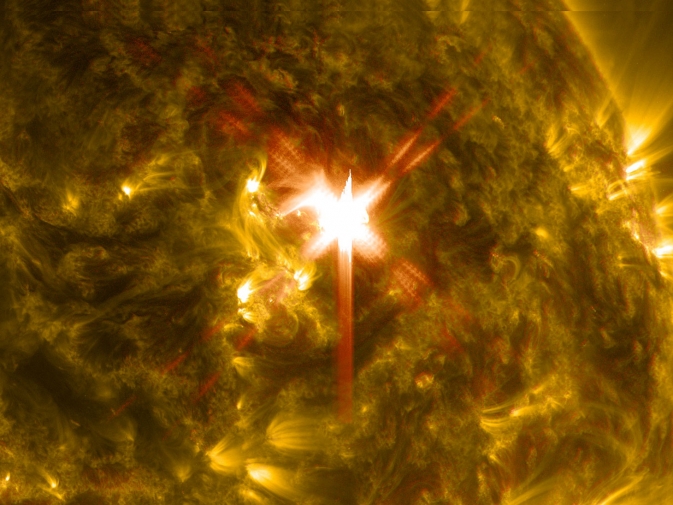.

Extreme ultraviolet light streams out of an X-class solar flare as seen in this image captured on March 29, 2014, by NASA's Solar Dynamics Observatory. This image blends two wavelengths of light: 304 and 171 Angstroms, which help scientists observe the lower levels of the sun's atmosphere.
.
The sun emitted a significant solar flare, peaking at 1:48 p.m. EDT March 29, 2014, and NASA's Solar Dynamics Observatory captured images of the event. Solar flares are powerful bursts of radiation. Harmful radiation from a flare cannot pass through Earth's atmosphere to physically affect humans on the ground, however -- when intense enough -- they can disturb the atmosphere in the layer where GPS and communications signals travel.
To see how this event impacted Earth, please visit NOAA's Space Weather Prediction Center at http://spaceweather.gov, the U.S. government's official source for space weather forecasts, alerts, watches and warnings.
This flare is classified as an X.1-class flare. X-class denotes the most intense flares, while the number provides more information about its strength. An X2 is twice as intense as an X1, an X3 is three times as intense, etc.
Quelle: NASA
.
IMPULSIVE SOLAR FLARE SCRAMBLES RADIO SIGNALS: On Saturday, March 29th, the magnetic canopy of sunspot AR2017 erupted, producing a brief but intense X1-class solar flare. A flash of extreme UV radiation sent waves of ionization rippling through Earth's upper atmosphere and disturbed the normal propagation of terrestrial radio transmissions. Radio engineer Stan Nelson of Roswell, NM, was monitoring WWV at 20 MHz when the signal wobbled then disappeared entirely for several minutes:
.

"The Doppler shift of the WWV signal (the 'wobble' just before the blackout) was nearly 12 Hz, the most I have ever seen," says Nelson.
The flare not only blacked out radio signals, but also produced some radio signals of its own. The explosion above sunspot AR2017 sent shock waves racing through the sun's atmosphere at speeds as high as 4800 km/s (11 million mph). Radio emissions stimulated by those shocks crossed the 93 million mile divide to Earth, causing shortwave radio receivers to roar with static. Here is a plot of the outburst detected by Nelson using a 20.1 MHz RadioJove receiver. Elsewhere, strong bursts were recorded at frequencies as high as 2800 MHz. It was a very broad band event.
Quelle: SpaceWeather
5159 Views
